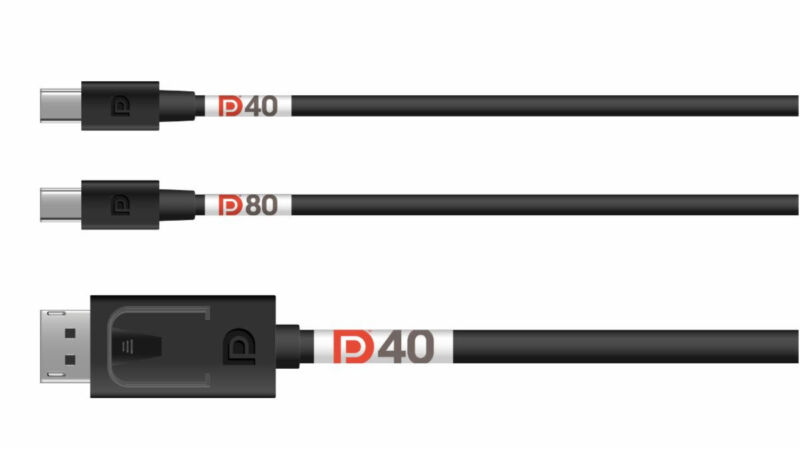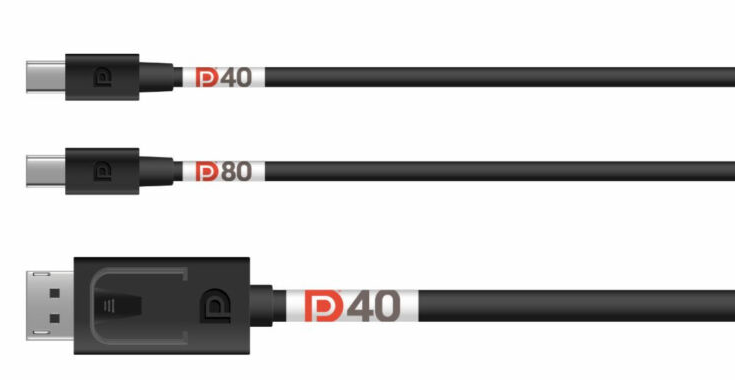
VESA
VESA, which makes the DisplayPort spec, today announced a certification program aimed at helping consumers understand if a DisplayPort 2.0 cable, monitor, or video source can support the max refresh rates and resolutions the spec claims.
Technology certifications, like DisplayPort and HDMI, generally provide an overview of associated products’ capabilities to give shoppers an idea of expected performance, like a monitor’s max speed or cable’s max bandwidth, before even using them.
VESA’s latest certification is around DisplayPort 2.0. The spec can support a max throughput of 80Gbps compared to DisplayPort 1.4’s 32.4Gbps. This enables extreme uses, like 16K resolution with display stream compression (DSC), 10K without compression, or two 8K HDR screens at 120 Hz.
But just because a monitor or cable, for example, is DisplayPort 2.0-certified doesn’t mean that’s the performance you’ll get.
The Ultra-high Bit Rate (UHBR) Certification is what you’ll have to check for if you want to be certain about these figures. VESA’s new “DP80 UHBR” certification means the display, cable, or video source supports up to a 20Gbps link rate (what VESA calls UHBR20) and a throughput of up to 80Gbps via four lanes.
Meanwhile, “DP40 UHBR” certification calls for support for a 10Gbps link rate (UHBR10) and a maximum throughput of 40Gbps via four-lane operation.
Of course, it’s possible that some products will still claim such performance without going through VESA’s certification process, but UHBR certifications seem to be the only way to know for sure if the DisplayPort 2.0 product will give you that impressive bandwidth.
UHBR-certified cables
There should eventually be UHBR-certified monitors and video sources, but today’s announcement is only accompanied by UHBR-certified cables. According to VESA, there are now DisplayPort and Mini DisplayPort DP40 and DP80 cables from companies including Accell, Bizlink, and WIZEN. The cables are also backward-compatible with other DisplayPort link rates, such as HBR 3 and 2.
In a statement, James Choate, compliance program manager for VESA, said that DP40 and DP8 cables were enabled by “improvements in both the DisplayPort connector and cable design.”
In terms of DisplayPort over Alt Mode, VESA noted that “full-feature passive USB-C cables already support UHBR bit rate speeds.” It added that UHBR-certified USB Type-C-to-DisplayPort converter cables will be available “soon.”
VESA also said that “multiple video source and display products” it’s currently testing should be DisplayPort UHBR-certified “soon.”
Trying to avoid confusion
The amount of bandwidth a DisplayPort product supports has effects on the technology’s capabilities. For example, the theoretical max refresh rate of 4K on Windows with DisplayPort 2.0 is 569 Hz with DisplayPort 2.0 and UHBR13.5 but 749 Hz if you move to UHBR20 (of course, there are no monitors or graphics cards currently that support that).
VESA’s DisplayPort rivals HDMI, which reigns in the TV space. And VESA learned a lesson from the HDMI Licensing Administrator’s handling of the HDMI 2.1 spec. In December, the spec maker saw backlash when it was made apparent that HDMI 2.1 actually replaces HDMI 2.0, so products with features maxing out what was typically considered HDMI 2.0-level performance could still be labeled HDMI 2.1.
“It’s kind of a recognized problem now …,” Craig Wiley, VESA board member, told Ars Technica. “As these new standards come out that have these options of supporting all these great features… just because they’re certified to that new standard, doesn’t mean they’re all supported—that’s something that has to be communicated.”
Ars was told that VESA didn’t initially focus heavily on UHBR when it announced DisplayPort 2.0 in 2019, as it feared marketing “confusion.” Having to look for a spec within a spec doesn’t scream simplicity, but at least the group is providing a path to understanding.



